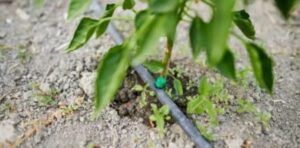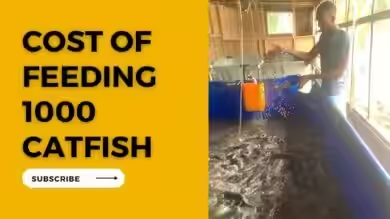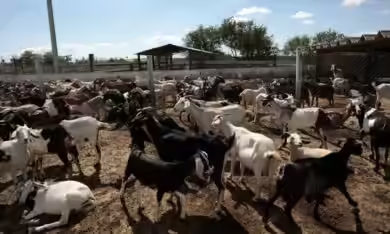Last updated on August 7, 2025
For many of us, sweet potato farming in Nigeria is foundational. It underpins our food security and economy. But climate change means battling erratic rainfall and prolonged dry seasons. Relying on rainfed agriculture is increasingly risky, often slashing yields. That’s why innovative irrigation techniques aren’t just an option; they’re essential. Implement these water-saving irrigation practices to boost yields and enhance resource efficiency, helping you adapt to this new normal.
The demand for sweet potatoes is surging! They hold immense potential as a cash crop. However, rainfed agriculture simply can’t consistently meet this trend. Fluctuating water supply directly translates to unstable harvests. You must produce more, reliably, year-round. This challenge isn’t just about water access; it’s about smart water management that is efficient and sustainable. Start now to ensure your sweet potato production thrives.
Understanding Sweet Potato’s Water Needs: Beyond “Drought-Tolerant”
Sweet potatoes are often called “drought-tolerant,” but surviving isn’t enough; we want them to thrive and deliver bumper harvests! To truly revolutionize sweet potato cultivation, understand their precise crop water requirements. Different growth stages demand specific care.
Sweet Potato’s Water Requirements at Different Growth Stages
A sweet potato’s thirst changes significantly through its life cycle. Getting it right is crucial for a great harvest.
- Initial Stage (Planting to Root Development): Ensure high moisture for successful establishment and vigorous root growth. This lays a strong foundation for the entire plant.
- Vegetative Growth and Tuber Initiation: Provide consistent moisture during this sweet spot. Erratic water supply conditions here severely stunt growth and compromise tuber numbers. Aim for steady water.
- Tuber Bulking: Tubers rapidly expand now. They need adequate water, but consider a slight reduction to improve quality and prevent cracking.
- Maturity/Harvest: Reduce watering to prevent cracking and rot, preparing tubers for storage. Sweet potatoes generally need 450-650mm of well-distributed rainfall throughout their cycle. Plan accordingly.
The Dangers of Too Little (Drought Stress) vs. Too Much (Waterlogging)
It’s a fine line. Both extremes can spell disaster. Your water management must actively avoid both pitfalls.
- Drought Stress: Too little water leads to drought stress. Expect stunted growth, poor root development, and lower yields. Tubers often become misshapen or fibrous. Act early to prevent this.
- Waterlogging: Conversely, too much water causes waterlogging. Roots are deprived of oxygen, leading to damage, restricted systems, and tuber rot. Plants also become highly susceptible to diseases. Prioritize proper drainage as it’s as vital as proper irrigation.
Current Irrigation Challenges Facing Sweet Potato Farmers in Nigeria
Farming sweet potatoes in Nigeria presents tough challenges related to water. These stem from environmental shifts, outdated practices, and access issues. Recognize these hurdles to overcome them.
Erratic Rainfall and Prolonged Dry Seasons: A Major Constraint
Climate variability is a huge issue. Erratic rainfall disrupts planting schedules and crop cycles. During prolonged dry seasons, meeting sweet potato’s water requirements becomes a struggle. Without consistent water, drought stress hits, and expected yields vanish. Prepare for this unpredictability.
Inefficient Traditional Irrigation Practices and Water Loss
Many Nigerian farmers still use inefficient irrigation methods like flooding or manual watering. These practices cause significant water loss through runoff, deep percolation, and evaporation. Stop pouring water into a leaky bucket; adopt better methods to maximize effective water use.
High Costs, Limited Access, and Lack of Knowledge for Smallholder Farmers
High cost of irrigation is a major hurdle for smallholder farmers Nigeria. The initial capital investment for modern irrigation can be prohibitive. Beyond cost, limited access to equipment and a lack of knowledge about advanced irrigation solutions persist. Seek out extension services and practical training to bridge this gap.
Soil-Related Issues: Compaction, Poor Drainage, and Nutrient Leaching
Soil conditions also add to our woes. Soil compaction hinders water infiltration, leading to runoff. Poor drainage directly causes waterlogging and root rot. Additionally, improper water management often results in nutrient leaching, washing away vital nutrients before plants can absorb them. Address these soil issues to improve soil fertility and farm returns.
Innovative Irrigation Techniques for Sweet Potato Farming in Nigeria: Smart Solutions for Higher Yields
Enough with the problems! Let’s explore smart irrigation solutions that empower sweet potato production in Nigeria. These innovative irrigation techniques are practical, water-saving methods designed for yield improvement and profitability. Implement them for tangible results.
Drip Irrigation: Precision Watering for Maximum Efficiency
Drip irrigation is a superstar among efficient irrigation methods. Start using it to deliver precisely measured water directly to your plants.
1. How Drip Irrigation Works for Sweet Potatoes
Drip irrigation uses a network of narrow tubes with emitters, releasing water slowly at the plant’s root zone. Every drop goes where needed, minimizing waste. This irrigation method works effectively for both small and large-scale operations. Consider investing in a basic drip system to begin.
2. Advantages: Water Saving, Nutrient Delivery, Reduced Weeds
Drip irrigation offers substantial benefits, primarily by saving water. You can cut water consumption by up to 70%. You can also apply nutrients directly (fertigation), minimizing nutrient leaching. By wetting only the crop zone, it discourages weed growth between rows. This leads to improved yield and quality consistency, boosting productivity. Expect better harvests with less water.
3. Considerations for Adoption by Nigerian Farmers: Cost and Maintenance
The initial capital investment for drip irrigation can be a hurdle for smallholder farmers Nigeria. However, long-term farm returns from water savings often outweigh this. Explore financing options like micro-credits and simple maintenance. Maintenance is relatively simple, often involving just clearing emitters. Also, consider that proper training is key for successful installation and operation; seek out training programs in your area to overcome potential knowledge barriers.
Raised Beds and Mounds: Mastering Drainage and Moisture Retention
For sweet potatoes, especially in waterlogging-prone areas, raised beds or mounds can be a lifesaver. Start building them if your soil has drainage issues.
1. The Science Behind Raised Beds for Sweet Potatoes
Elevated raised beds significantly improve soil aeration and drainage. This is crucial for robust root development and optimal tuber formation, particularly beneficial in heavy or poorly drained soils. It improves oxygen availability to roots and tubers, promoting healthier growth.
2. Benefits: Preventing Waterlogging, Enhancing Root Development, Ease of Management
Preventing waterlogging is vital for avoiding root rot and ensuring healthy tuber growth. These structures also facilitate manual weeding and harvesting. Agricultural research consistently shows yield increases with raised beds due to improved drainage and growing conditions for crops like sweet potatoes. Implement raised beds to protect your crop from excess water.
3. Practical Steps for Constructing Effective Raised Beds
Aim for beds 20-30 cm high and 75-90 cm wide, with adequate spacing. Simple tools like hoes are sufficient. Integrate them with drip lines or mulching to enhance moisture retention.
Strategic Mulching: A Simple Yet Powerful Water Conservation Technique
Mulching is an age-old trick still vital for water conservation in sweet potato cultivation. Start applying mulch today.
1. Organic vs. Plastic Mulches: What Works Best for Sweet Potatoes in Nigeria?
Organic mulches (crop residues, straw) improve soil organic matter and gradually release nutrients. Plastic mulches (black, clear) are effective for weed suppression and soil warming, but have higher costs and disposal concerns. For smallholder farmers Nigeria, organic options are often more accessible and sustainable initially.
2. How Mulching Reduces Evaporation and Suppresses Weeds
Mulching creates a barrier over the soil surface, significantly slowing evaporation. This means more water stays in the soil. It also shades out weeds, reducing competition for water and nutrients, improving water use efficiency. Use mulch to keep soil moist longer and suppress weeds.
3. Integrating Mulching with Other Innovative Irrigation Techniques for Sweet Potato Farming in Nigeria
Mulching synergizes beautifully with other advanced irrigation practices. Combine it with raised beds to improve drainage and moisture retention. With drip irrigation, mulch locks in moisture, almost eliminating evaporation. This duo creates an optimal environment for sweet potato production.
Smart Irrigation Scheduling: Optimizing Water Application
Knowing when and how much to water is crucial. Smart irrigation scheduling is a precise water management technique. Learn to schedule your irrigation effectively.
1. Understanding Crop Water Requirements (Evapotranspiration, Soil Type)
Smart irrigation begins with understanding crop water requirements. Consider evapotranspiration (influenced by temperature, humidity, wind) and soil type. This helps tailor irrigation, preventing both drought stress and waterlogging. Research your specific sweet potato variety’s water needs.
2. Leveraging Weather Forecasts and Simple Tools (e.g., Soil Moisture Checks)
You don’t need fancy tech for smart scheduling. Use local weather forecasts to plan irrigation. Simple field tests like the “feel and appearance” method assess soil moisture. These soil moisture checks are accessible and fundamental for soil moisture management. Regularly check your soil moisture by hand.
3. Introduction to Sensor-Based Irrigation for Future Adoption
Sensor-based irrigation is exciting for the future. Tiny soil moisture sensors automate watering, ensuring precise applications. While an investment for many Nigerian farmers, this technology promises data-driven farming, maximizing water use efficiency and productivity. Stay informed about these emerging technologies.
Supplementary Irrigation for Dry Season Sweet Potato Production
Supplementary irrigation extends sweet potato production beyond rainy months, ensuring year-round availability. Plan for dry season irrigation.
1. Ensuring Consistent Water Supply During Critical Periods
Even during the rainy season, supplementary irrigation fills gaps, meeting peak water demand. It ensures consistent water supply conditions, preventing drought stress at crucial stages. This boosts yield improvement and stabilizes harvests. Don’t let dry spells impact your critical growth stages.
2. Small-Scale Solutions for Off-Season Vine Conservation
Using irrigation during the dry season to conserve sweet potato vines is smart. This ensures readily available, high-quality planting material for the next season. It enables vine multiplication, impacting year-round planning and resource optimization. Conserve your vines with targeted dry season watering.
Beyond Irrigation: Holistic Approaches for Water-Smart Sweet Potato Farming
Innovative irrigation techniques are vital, but water-smart sweet potato farming needs a holistic approach. It’s about a resilient system where every element works together, boosting yield improvement and safeguarding against water scarcity. Adopt these integrated practices.
Selecting Drought-Tolerant Sweet Potato Varieties for Nigerian Conditions
Choosing the right sweet potato variety is foundational for success, especially with unpredictable rainfall. Always choose varieties suited to your local conditions.
1. The Role of Genetics in Water Resilience
Genetics play a huge role in a plant’s ability to handle stress. Plant breeders develop drought-tolerant sweet potato varieties with mechanisms to cope with less-than-ideal water supply conditions, offering a significant head start.
2. Recommended Varieties for Different Agro-Ecological Zones
Nigeria‘s diverse agro-ecological zones, from Abia State to the Sokoto Sudan savannah, require specific varieties. Consult your local agricultural extension services for recommended drought-tolerant varieties like “TIS 87/0087” or “UMUSPO 3” for your region.
Improving Soil Health for Enhanced Water Retention
Think of soil as a sponge. Improving soil health is crucial for effective water management and a core component of sustainable practices. Focus on building healthy soil.
1. Incorporating Organic Matter: Compost and Crop Residues
Adding compost or crop residues significantly increases your soil’s water holding capacity. This means more water infiltrates and less runs off, providing a consistent reservoir. It also boosts soil fertility, reducing reliance on chemical fertilizers. Regularly add organic matter to your soil.
2. Minimizing Soil Compaction
Compacted soil hinders water infiltration. Practices like reduced tillage ensure loose, crumbly soil, allowing water to infiltrate and roots to grow deeper. This improves drainage and soil moisture management, preventing waterlogging. Avoid excessive tillage to maintain soil structure.
Integrated Pest and Disease Management in Irrigated Sweet Potato Systems
While irrigation boosts growth, it can sometimes favor pests and diseases. Thus, smart, integrated management is crucial. Implement Integrated Pest Management (IPM). Choose resistant varieties, rotate crops, practice good field hygiene, and monitor for early signs of trouble. Targeted interventions protect beneficial insects and the environment, keeping irrigated sweet potatoes healthy.
Addressing the Barriers: Making Innovative Irrigation Accessible to Nigerian Smallholders
Getting advanced irrigation solutions to smallholder farmers Nigeria isn’t easy. We must address the real challenges to ensure accessibility. Actively seek support and resources.
Financing Innovative Irrigation Techniques: Micro-credits and Subsidies
Cost is often a barrier. Explore existing government programs, NGOs, and financial institutions. Micro-credits and subsidies can make water-saving irrigation systems like drip irrigation affordable. For example, the Central Bank of Nigeria (CBN) often has agricultural intervention funds (Source: General knowledge of agricultural financing in Nigeria).
Knowledge Transfer and Extension Services: Bridging the Information Gap
Knowledge is key. Seek out robust agricultural extension workers in your area for practical, hands-on training. Join farmer field schools to learn from your peers, demystify technology, and build confidence. This bridges the lack of knowledge and improves technical know-how.
Community-Based Approaches and Farmer Cooperatives
There’s strength in numbers. Join or form community-based approaches and farmer cooperatives to overcome individual challenges. Cooperatives can collectively purchase irrigation equipment, share resources like boreholes, and foster knowledge sharing. This boosts resource optimization and sustainable sweet potato cultivation.
Policy Support and Government Initiatives for Sustainable Agriculture
Government policy is critical for incentivizing sustainable agriculture and water-efficient farming. Advocate for investment in rural infrastructure (boreholes, dams) and incentives like grants for adopting advanced irrigation. Strong initiatives create an enabling environment for thriving sweet potato production, boosting food security.
Success Stories and Future Outlook: The Promise of Innovative Irrigation for Sweet Potato in Nigeria
Innovative irrigation techniques are already transforming sweet potato farming in Nigeria, showing us what’s possible and painting a bright future. Learn from these success stories and envision your own.
Case Studies of Farmers Adopting Modern Irrigation
I’ve witnessed incredible transformations firsthand. Farmers in Agbani, Enugu State, and even drier northern zones, embracing drip irrigation, now report consistent harvests. A particularly inspiring example is Mrs. Ngozi Okoro, a smallholder farmer from Kwara State. Before implementing drip irrigation, her sweet potato yields averaged about 8-10 tons per hectare. After securing a micro-loan and adopting a drip system, her yields soared to over 14 tons per hectare in her first irrigated season – a remarkable 40-75% increase!
Her farm returns dramatically improved, allowing her to expand and educate her children. These tangible successes, like Mrs. Okoro’s, prove the potential for increased productivity across Nigeria. Look for similar success stories in your local farming communities; they are all around us!
The Long-Term Impact on Food Security and Farmer Livelihoods
Widespread adoption of these innovative irrigation techniques means a massive leap for food security in Nigeria. Consistent sweet potato production year-round translates to a stable food supply. Less reliance on rainfed agriculture builds greater climate resilience. Beyond food, the impact on farmer livelihoods is profound. Increased productivity and reliable yield improvement lead to higher incomes and reduced poverty. Embrace these methods to build a more secure future for your farm and family.
Frequently Asked Questions (FAQs)
What is drip irrigation for sweet potatoes?
Drip irrigation delivers water slowly and directly to the sweet potato plant’s root zone through a network of tubes and emitters. This method minimizes waste and maximizes efficiency.
How much water does sweet potato need?
Sweet potatoes generally thrive with about 450-650mm of well-distributed rainfall throughout their growing cycle. Their water needs vary by growth stage, being highest during initial establishment and vegetative growth.
Are sweet potatoes drought-tolerant?
While sweet potatoes can survive periods of drought stress, to thrive and produce optimal yields, they require consistent and adequate moisture, especially during key growth stages.
What are the benefits of mulching for sweet potatoes?
Mulching significantly reduces evaporation from the soil, conserving water. It also suppresses weeds, reducing competition for water and nutrients, and can improve soil organic matter, ultimately boosting sweet potato production.
What is waterlogging in sweet potatoes?
Waterlogging occurs when soil becomes saturated with too much water, depriving sweet potato roots of oxygen. This leads to root damage, restricted growth, tuber rot, and increased susceptibility to diseases.
What are raised beds good for?
Raised beds are elevated planting areas that improve soil aeration and drainage. They are especially beneficial for sweet potatoes in heavy or waterlogged soils, promoting healthier root and tuber development.
Why is soil health important for water?
Good soil health, particularly through incorporating organic matter, significantly increases the soil’s water holding capacity. Healthy soil acts like a sponge, allowing more water to infiltrate and holding it for longer, reducing runoff and promoting efficient water management.
How can I get help with irrigation costs?
Smallholder farmers in Nigeria can explore various financing options. These include micro-credits from financial institutions, subsidies from government programs, and support from NGOs that aim to make water-saving irrigation more affordable.
Conclusion: Cultivating a Water-Secure Future for Sweet Potato in Nigeria
We’ve covered the critical need for innovative irrigation techniques in Nigerian sweet potato farming. Solutions like drip irrigation, raised beds, mulching, and smart irrigation scheduling transform harvests. Don’t forget drought-tolerant varieties, soil health, and integrated pest management.
It’s clear: embracing water-saving irrigation cultivates a water-secure future for sweet potato production in Nigeria. It builds resilience, boosts yield improvement, and ensures greater profitability.
I urge all farmers, policymakers, and stakeholders to embrace these innovative irrigation techniques. Let’s collaborate on financing, knowledge transfer, community support, and policy reforms. Together, we can unlock the full potential of sweet potato cultivation in Nigeria, ensuring a more abundant and prosperous agricultural sector for generations to come. What steps will you take today to embrace this water-smart future?


